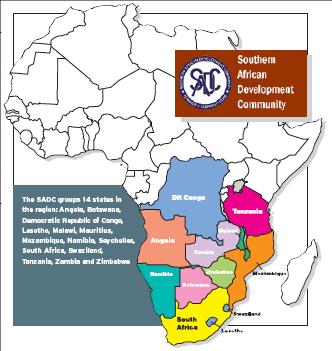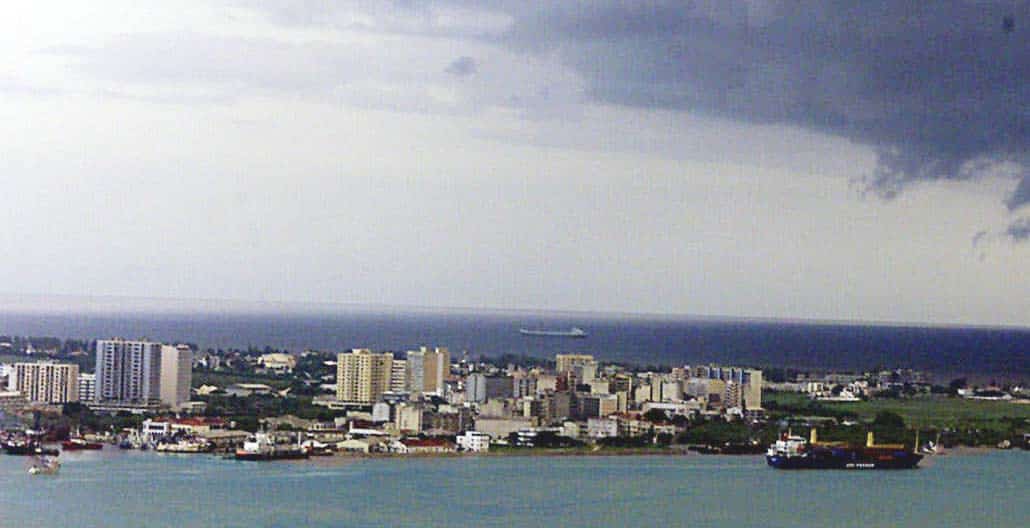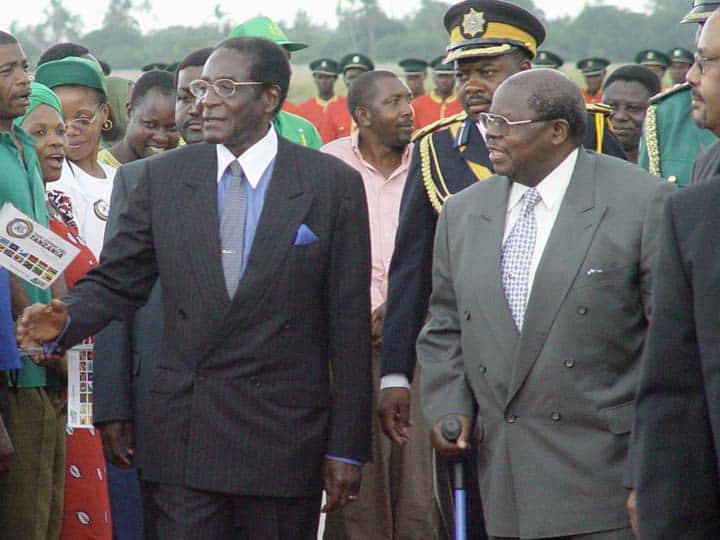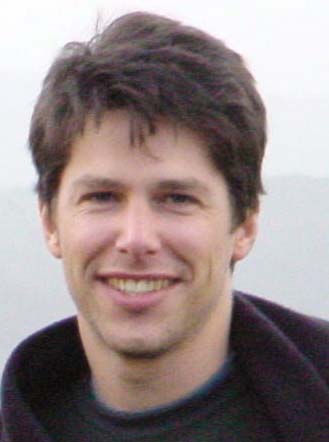Special Feature: Southern Africa
The challenges may be huge, but a handful of southern African nations are getting a boost in their efforts to fight poverty and improve their economic fortunes.

Early in June, on a steamy afternoon on Sea Island off the coast of Georgia, leaders from some of the worlds wealthiest nations met representatives of some of the poorest at the G8 summit. African leaders from Algeria, Ghana, Nigeria, Senegal, South Africa and Uganda met President George Bush, Prime Minister Tony Blair and the leaders of Canada, Italy, Russia, France, Japan and the European Union to discuss the many challenges facing the African continent.
On the agenda were key topics including combating poverty and dealing with Africas debts, tackling HIV and AIDS and increasing food security. These challenges are nothing new, particularly for the poorest African nations, many of which are part of the Southern African Development Community (SADC). Created as the Southern African Development Coordination Conference (SADCC) in 1980 by nine founding members, the SADC now groups 14 states in the region: Angola, Botswana, Democratic Republic of Congo,Lesotho, Malawi, Mauritius, Mozambique, Namibia, Seychelles, South Africa,Swaziland, Tanzania,Zambia and Zimbabwe. Its primary objectives include achieving development and economic growth in the region, alleviating poverty, enhancing the standard and quality of life of the people of southern Africa, promoting peace and security and encouraging the interdependence of member states.
 |
|
|
Despite the scale of the challenge, the SADC is confident it can effect real and positive change.Taking a leaf out of Europes book, it is trying to create an economic community and a common market along the lines of the European Union. In its favor, the region has a population of nearly 200 million and a combined GDP of around $196 billion. But by far the majority of that GDP is generated in South Africa, which has the strongest economy in the region, with 71% of SADCs GDP, but only a fifth of its population.
The SADCs predecessor, SADCC, worked hard to redress that balance and to help its members become less dependent on South Africa, which at the time was still under apartheid. Gabriel Oosthuizen, associate fellow of the Royal Institute for International Affairs, explains, Most of the countries were utterly dependent on South Africa economically, and they realized that they needed to change that. When the SADCC was established in 1980, 80% of the goods for international export by the six landlocked SADCC member statesMalawi, Zambia, Zimbabwe, Swaziland, Lesotho and Botswanawere directed through South African ports.The SADCC undertook a number of infrastructure projects including the upgrading of the Beira Port Transport System and the Beira Corridor in Mozambique. The efforts bore fruit, and after 10 years of the SADCCs deliberate efforts to change the situation, 80% of the regions traffic had been diverted away from South African ports.

|
|
Chairman of the Southern African Development Community, Tanzanian President Benjamin Mkapa (right) with Zimbabwean President Robert Mugabe. SADC is trying to encourage southern African leaders to work together against poverty |
T
he conference became a community when the SADC was created on August 17, 1992.The aim was to give the organization a more formal status and to change its focus from the coordination of development projects to the more complex task of integrating the economies of member states.
From the very beginning the SADC placed particular emphasis on member states formulating and implementing policy decisions. But by the mid-1990s it was becoming clear it was experiencing major difficulties. In 2001 it was agreed to re-structure and adopt a more centralized approach.
A report on the restructuring of the SADC by the Christian Michelsen Institute in Norway says: It was felt that the SADC Secretariat lacked the power, authority and resources required to facilitate regional integration. The sector-coordinating units in member states were highly uneven in their ability to pursue and implement policies. It was also argued that SADCs work plan lacked a clear regional focus, it covered too many areas, and the majority of projects were found to be mainly national.
Tighter Focus, Broader Goals
|
AFRICA STRUGGLES TO ATTRACT FOREIGN INVESTMENT |
|
One of the most serious problems that African nations need to address is that the continents share of foreign direct investment (FDI) is lagging far behind that of other regions, according to the Southern African Development Community (SADC). In the 1970s Africa received a greater proportion of FDI than either Asia or Latin America, but today it is a very different story, with Asia receiving nine times as much as Africa, and Latin America attracting five times as much. Africa in general has been pretty marginal in FDI flows for a long time, comments Peter Draper, trade research fellow at the South African Institute of International Affairs. Of the little FDI that does flow to Africa, South Africa has generally received the lions share of FDI to the region, netting $6.6 billion in 2001. Even South Africa is suffering, though, as a result of its neighbors crises. New research published by South African Economic Society president Professor Elsabe Loots shows that if there are major problems in one country in a region, it will deter FDI from its neighbors, no matter how financially stable they are. This means, for example, that while South Africa is doing everything right economically, the low perceptions of the region, and specifically Zimbabwe, will drive away much needed investment, says Loots. Investors caution is understandable. According to World Bank economist Alan Gelb, Africas barriers to FDI include the perception that investment risks are too high, African countries exchange rates are too uncertain, and the cost of doing business is often 40% higher than it should be. Efforts to attract FDI to the SADC region have not been easy, with many investors driven away by the political instability of the region and recent military conflicts in Angola and the Democratic Republic of Congo. Clearly, where you have dysfunctional states, civil wars and so on, then development is going to be curtailed, says Draper. A report by the Policy Research Unit at the University of Cape Town in South Africa says the small size of the SADC market could be another issue. Several of the countries that have attracted large amounts of FDI, such as China and Brazil, offer very large domestic markets or are close to large markets to which investors can export. The SADC market is smaller than that of Turkey and about one-fifth of the size of the United States market. The regions distance from major markets in Europe, the US and Asia also makes it difficult for SADC to attract investment. The report by the University of Cape Town also found a strong link between regional integration agreements and FDI and concluded that the existence of regional integration agreements has a critical influence on attracting long-term investment. The SADC is working to increase its competitive advantage as a sub-Saharan Africa destination for FDI through deepening cooperation among its member states, including plans for the creation of a free-trade area by 2008. Speaking at a briefing ahead of the Integrated Committee of Ministers meeting in June, SADC executive secretary Prega Ramsamy said a free-trade area would create a wider economic space where goods and services can move without tariffs and will attract investment to the region. According to Ramsamy, the SADC market of 215 million people also provides an incentive for domestic, cross-border and foreign direct investment. But global experience suggests that integration alone will not attract foreign investors. We need to convince global investors that this region is worth investing in, says Loots. |
On March 12 of this year, the SADC launched a landmark initiative that should help its member nations focus on the most important issues they are facing: poverty and economic development.The Regional Indicative Strategic Development Plan (see box on page 53) is geared to meeting the United Nations Millennium Development Goal of halving the number of people living in poverty in the region by 2015. To do this, the region needs to reach an annual economic growth rate of at least 7%. Among the majority of the SADCs members, that growth rate might well be simply unachievable.According to SADC, economic growth in the regionincluding South Africais projected to run at just above 3% in both 2003 and 2004. Achieving a higher rate of growth will require higher levels of domestic savings, foreign direct investment and external development assistance.
Racking up that level of growth might be possible if the all the nations in the region were able to work together effectively. That might not happen any time soon, though.A report published by Gina van Schalkwyk of the South African Institute of International Affairs says that countries in SADC are unlikely to achieve the EUs cohesiveness in the short term due to the enormous disparities between countries like South Africa on one hand and Angola and the Democratic Republic of Congo on the other.
Oosthuizen, who is writing a book about the SADC, agrees. How do you meaningfully integrate a region like SADC if you have an economy like South Africa that dwarfs the other economies in the region? he asks. Despite this, Oosthuizen believes South Africas membership in SADC is a positive thing.Peter Draper, trade research fellow at the South African Institute of International Affairs, concurs.South Africa has a critical role to play, he says.If you look at foreign direct investment flows into the region, South Africa is the main destination, he adds.
It is understandable that investors should feel most comfortable putting their money into South Africa, but even that country could benefit, Oosthuizen believes, if a more regional approach were adopted for attracting FDI.There should be a coordinated approach, and South Africa should actively encourage investors to invest elsewhere in the region, he says. At a regional level they should also decide on regional priority areas for invest-ment, he adds. FDI is far more likely to flow into South Africa if its neighbors were seen to be attracting investment and working to stabilize and grow their economies (see box on page 52).
Free Trade Free-For-All
|
FIGHTING POVERTY THROUGH ECONOMIC GROWTH | ||
Earlier this year the SADC unveiled a blueprint for fighting poverty in southern Africa. The Regional Indicative Strategic Development Plan (RISDP) was launched by the chairman of the SADC, Benjamin William Mkapa, in early March at the start of a two-day SADC Council of Ministers meeting in Arusha, Tanzania. The plan, which will be reviewed on a fiveyearly basis, aims to promote regional cooperation in ensuring food security and in combating the HIV and AIDS pandemic while also encouraging gender equality, science and technology, and human and social development. Its overriding aim is for the region to achieve an average annual economic growth rate of at least the 7% necessary to halve the number of people living in poverty in the region by 2015. Gabriel Oosthuizen, associate fellow of the Royal Institute for International Affairs, says it is unlikely to achieve this goal but notes that it is important that an attempt has been made to prioritize some of the pressing issues affecting the region and set goals for tackling them. HIV and AIDS continues to be the biggest health challenge in the region. In his foreword to the regional plan, Mkapa admits the HIV and AIDS pandemic is undermining the regions development efforts. Gender inequality is also hindering economic development, something the RISDP addresses by setting specific targets in all national and regional policies, programs and activities. In science and technology, the RISDP aims to develop and strengthen national systems of innovation and increase the use of modern communication technology in the region. Trade promotion, economic liberalization and development are also highlighted, with emphasis on the formation of a SADC free-trade area by 2008. The real challenge now is to ensure this ambitious blueprint is embraced at a national level. SADC executive secretary Prega Ramsamy notes, Like an aircraft on the runway, we are facing in the right direction it is indeed time for us to take off on the wings of the RISDP. |
The SADC is working toward achieving a free-trade zone by 2008, which would see zero tariffs on trade between SADC nations and common external tariffs. SADC executive secretary Prega Ramsamy has said creating a free-trade zone by 2008 would be the first step toward achieving a customs union and, subsequently, a common market.
Unfortunately, the SADC also has some strategic challenges to contend with from organizations such as the Common Market for Eastern and Southern Africa (Comesa) and the Southern African Customs Union (SACU), says Draper, who points out that there is significant overlap between the organizations.All five SACU members are members of SADC, and eight SADC members are also members of Comesa. SACU is already in negotiations toward a free-trade agreement with the US, and Comesa is currently in the process of setting up its own customs union.There has also been talk of SACU expanding, with Mozambique and other SADC countries considering joining, says Oosthuizen. The overlap in some instances of some trade integration and regional economic schemes is a big problem, he adds.
The political instability of the region is another hurdle to its economic growth.
But despite its continuing challenges, SADC has made many achievements. The region has a lot of problems,admits Oosthuizen, but it doesnt follow that these are insurmountable.
SADCs very ambitious trade and economic integration goals will probably not be realized in the foreseeable future. But it doesnt mean that important steps wont be taken to meaningfully increase trade and economic cooperation in the region,Oosthuizen adds.
|
SADCS KEY AIMS |
|
Achieve development and economic growth, alleviate poverty, enhance the Evolve common political values, systems and institutions. Promote and defend peace and security. Promote self-sustaining development on the basis of collective self-reliance and the interdependence of member states. Achieve complementarity between national and regional strategies and programs. Promote and maximize productive employment and utilization of resources of the region. Achieve sustainable utilization of natural resources and effective protection of the environment. Strengthen and consolidate the long-standing historical, social and cultural affinities and links among the peoples of the region. |
CLARE VINCENT





